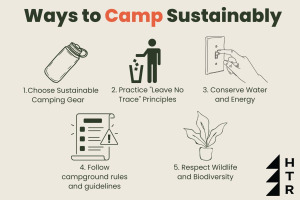
Camping has become an increasingly popular activity that allows us to connect with nature, relax, and unwind from our busy lives. However, as our awareness of environmental issues grows, it’s important to consider the impact of our camping activities on the planet. Sustainable camping is a way to enjoy the great outdoors while minimizing our ecological footprint. In this forum, we will explore the beauty of sustainable camping and share five tips for eco-friendly outdoor adventures.
1. Choose Sustainable Camping Gear
Choosing sustainable camping gear is a crucial aspect of camping in an eco-friendly manner. To do this, look for gear that is made from recycled or organic materials, as it helps reduce the demand for new resources and minimizes waste. Tents made from recycled fabrics, sleeping bags with insulation made from recycled down or synthetic materials, and cookware made from durable, long-lasting materials like stainless steel or cast iron are great options. Additionally, consider the durability and longevity of the gear, opting for items that can be used for multiple trips rather than single-use items that contribute to landfill waste.
2. Practice “Leave No Trace” Principles
“Leave No Trace” is a set of ethical principles that encourages campers to minimize their impact on the environment. These principles include packing out all trash, disposing of waste properly, camping in established campsites, staying on designated trails, and respecting wildlife and other campers. By following “Leave No Trace” principles, you can help preserve the natural beauty of the camping area and minimize your ecological impact.
3. Conserve Water and Energy
Conserving water and energy is a valuable way to practice sustainable camping. Turn off taps when not in use, and collect rainwater for washing dishes or watering plants. Additionally, use rechargeable batteries or solar-powered devices for your camping needs to minimize the use of disposable batteries and reduce waste. Remember to turn off lights and appliances when not in use, and follow local safety regulations when using a campfire.
4. Follow the Campground Rules and Regulations.
It’s essential to find a campground that has established set rules and regulations in place for its campers. Many established campgrounds have designated campsites with fire rings, picnic tables, and bathroom facilities, which can help minimize your impact on the surrounding environment. Using established facilities instead of creating makeshift campfires or latrines can prevent damage to vegetation, soil erosion, and contamination of water sources. By camping on established campsites and adhering to campground guidelines, you can enjoy the outdoors while minimizing your ecological footprint and promoting sustainable camping practices.
5. Respect Wildlife and Biodiversity
One of the joys of camping is encountering wildlife in their natural habitats. However, it’s important to respect wildlife and biodiversity by observing animals from a safe distance, not feeding them, and not disrupting their natural habitats. Avoid trampling on vegetation and stay on designated trails to protect local plants. Be respectful of the environment by leaving the camping area as you found it.
All five of these practices can help plant seeds for future generations to come on healthy eco-friendly ways to camp. The methods we implement now will carry on into the future. We have a great responsibility to respect and look after the Earth and the wildlife around us. By following these tips, you can not only enjoy your time camping but also conserve the nature around you.
